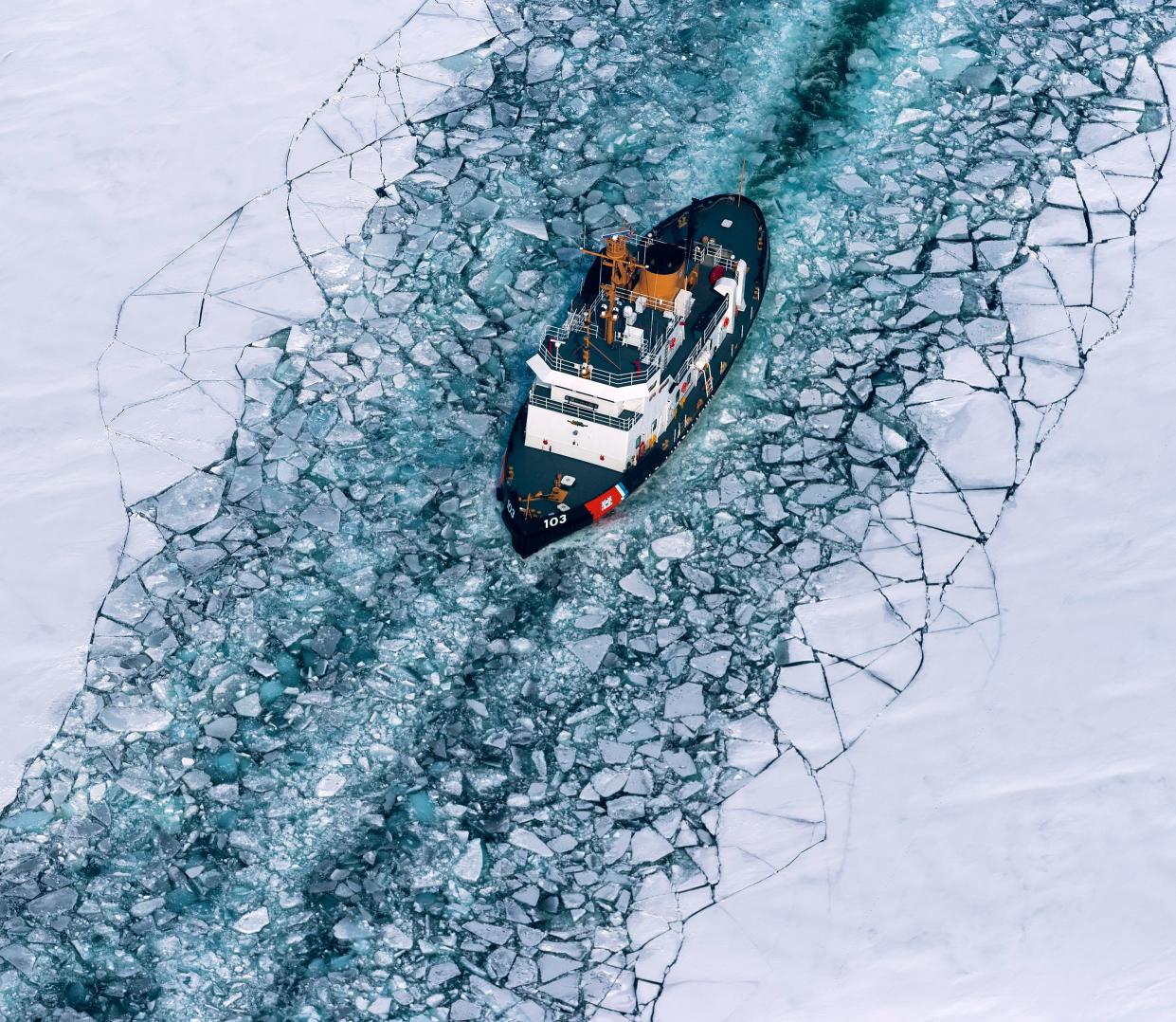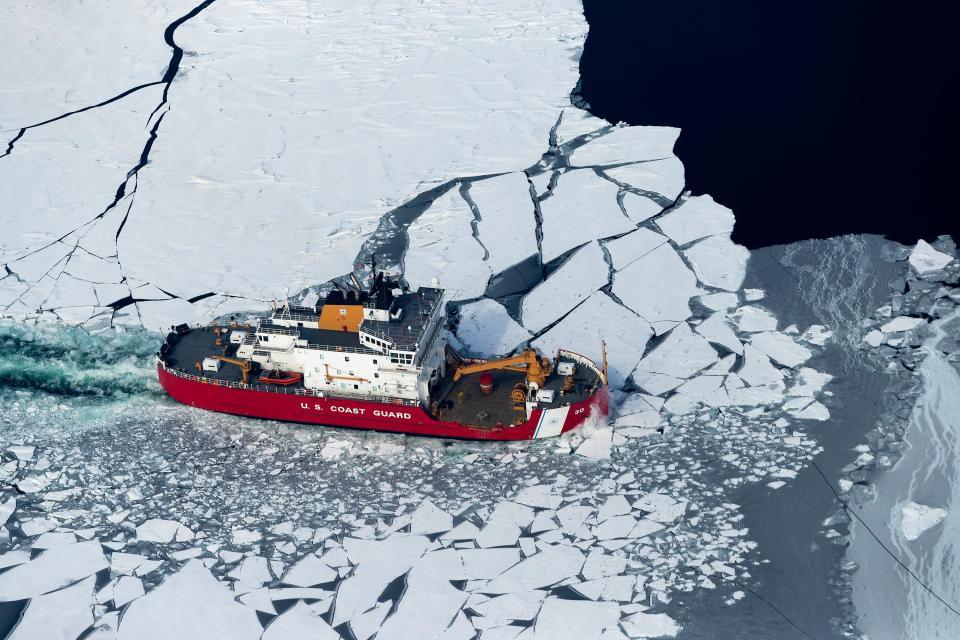Ice is a major barrier to Great Lakes shipping. New legislation is delivering a $350 million icebreaker to keep the waters open.

- Oops!Something went wrong.Please try again later.
Tucked in a massive bipartisan bill approved in Congress to fund the national defense is a measure that will bring a much-needed boost to the Great Lakes shipping industry.
The National Defense Authorization Act, headed to President Joe Biden's desk, includes a measure called the Great Lakes Winter Commerce Act that delivers an $350 million icebreaker to the U.S. Coast Guard's fleet.
Keeping shipping lanes open by icebreaking is an integral part of commerce on the Great Lakes in the winter months. Icebreaking in the Great Lakes supports shipping more than 90 million tons of cargo each year.
“We really need an additional (icebreaker) to be able to keep commerce going,” said U.S. Sen. Tammy Baldwin, who helped spearhead the commerce act through Congress. “The consequences when we cannot keep up with that icebreaking mission are pretty dire.”
Republican U.S. Rep. Mike Gallagher joined Baldwin in moving the measure, along with Republican U.S. Sen. Todd Young of Indiana and Democratic U.S. Sen. Gary Peters of Michigan.
When ships get stuck in the ice it can cause major delays and supply chain issues — a problem that’s only been heightened since the pandemic began.
And water commerce is especially important to a state like Wisconsin, flanked by two Great Lakes as well as the Saint Croix and Mississippi Rivers.
“I think a lot of folks don't recognize how much of our commerce is conducted over water,” Baldwin said. “So the investments that we make … are hugely important.”

Icebreaking keeps commerce afloat in ice-covered waters
If the Great Lakes region was its own country it would have the third largest economy in the world after the U.S. and China, according to the Council for the Great Lakes Region.
And shipping is the backbone of that economy.
Unfortunately the U.S. and Canada don’t have the capacity to keep ships on the move in the winter months. The fleet must look after more than 2,300 miles from Duluth, Minnesota, to the Atlantic Ocean and the 94,000 square miles of ice-covered lakes in between.
Last winter alone, the U.S. Great Lakes shipping industry lost a month’s worth of work due to ice-delays. Nearly 1.7 million tons of cargo were delayed 680 hours — or 28 days, said Eric Peace, the vice president of the Lake Carriers’ Association.
During the 2018-19 ice season, which was especially icy, the Great Lakes maritime industry lost more than a billion dollars, according to a study by the Lake Carriers' Association. More than 5,000 jobs were lost throughout the region in an industry that is already having a tough time recruiting new workers.
More:What's the state of the Great Lakes? Successful cleanups tempered by new threats from climate change
To date, the U.S. Coast Guard owns nine icebreakers while the Canadian Coast Guard owns two. Only one icebreaker in the fleet, the Mackinaw, is a “heavy” icebreaker capable of leaving a wide enough path for large freighters to pass though.
The new icebreaker will be similar in size to the Mackinaw.
“The reality of it is we could probably use 100 icebreakers to move everyone efficiently,” Peace said.
Icebreaking also serves another purpose: flood control. Ice jams can form at the mouths of tributaries through the lakes, blocking water from flowing into the lake and flooding communities, Peace said. The U.S. Coast Guard can bring in icebreakers to prevent this from happening.

Provisions in the act also require the U.S. Coast Guard to provide an annual report to Congress on its ice-breaking activities and update its metrics.
Right now, the agency only measures icebreaking and delays in the connecting waterways: the St. Mary’s River that drains Lake Superior; the Straits of Mackinac that connect Lakes Michigan and Huron; the St. Clair River that connects Lakes Huron and Erie; and Pelee Passage in Lake Erie.
So, if a ship was stuck in the bay of Green Bay, it wouldn’t count it, Peace said, suggesting that the problem was starker than the numbers showed.
Now, the Coast Guard will be better resourced to do so.
“I just think that this is a huge success for the men and women of the Coast Guard,” Peace said. “They deserve to be adequately resourced to do their mission.”
Milwaukee, the Fox-Wolf watershed, Upper Mississippi River will also benefit from bill
Funds from the bill will also be heading directly to the city of Milwaukee. The legislation provides $4.5 million to help the Milwaukee Metropolitan Sewerage District strategically implement green infrastructure throughout the city. Green infrastructure will help make Milwaukee more resilient to climate change by lessening the impacts of heavy rain events.
In the Fox-Wolf watershed, funding will be available to study how the reduced water storage capacity causes water levels in Lake Winnebago to rise during storms and after spring snowmelt. The study will lay the foundation for implementing green infrastructure and in turn reducing flooding and improving water quality.
On the Upper Mississippi River, the bill provides the U.S. Army Corps of Engineers the authority to manage water levels to both restore natural habitats and maintain navigation.
Caitlin Looby is a Report for America corps member who writes about the environment and the Great Lakes. Reach her at clooby@gannett.com or follow her on Twitter @caitlooby.
Please consider supporting journalism that informs our democracy with a tax-deductible gift to this reporting effort at jsonline.com/RFA or by check made out to The GroundTruth Project with a subject line Report for America Milwaukee Journal Sentinel Campaign. Address: The GroundTruth Project, Lockbox Services, 9450 SW Gemini Dr, PMB 46837, Beaverton, Oregon 97008-7105.
Our subscribers make this reporting possible. Please consider supporting local journalism by subscribing to the Journal Sentinel at jsonline.com/deal.
DOWNLOAD THE APP: Get the latest news, sports and more
This article originally appeared on Milwaukee Journal Sentinel: Defense authorization bill brings $350 million Great Lakes icebreaker

